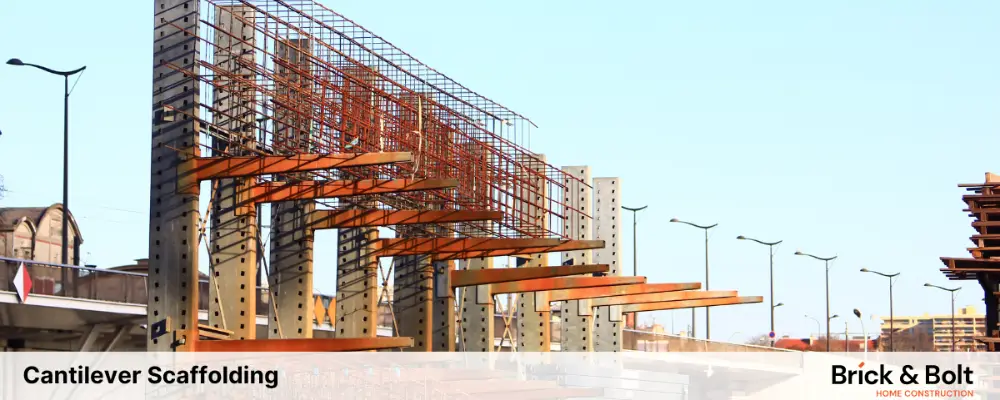If you are working on a construction site, industrial project, or any other commercial project, then the usage of cantilever scaffolding is invaluable. It is used to create a new working platform for the workers to simplify workflow. This stable platform allows the workers to carry out their work from the horizontal side of the building. Let us explore the use cases and benefits of cantilever scaffolding.
What is Cantilever Scaffolding?
Cantilever scaffolding is a system that is used in construction projects and maintenance. It assists in creating a platform for workers on the side of the building or the structure.
It is sustained at one end and extended to another end. It has a horizontal platform that extends from the building to the structure and is supported by needles from the ground. Thus, support the workers access difficult sides or areas of the building or the structure.
Structure of Cantilever Scaffolding
Main Frame
The main frame provides the primary support for the cantilever scaffolding. This base foundation connects it to the building or the structure.
Cantilever Beam
This is an extended horizontal platform arising from the main frame. It provides a place for the workers to carry out their day-to-day activities. Without any vertical support, it extends outward from the main frame.
Needle Beam
The needle beams support the cantilever beam by extending inwards. It manages the load capacity and strengthens the beam.
Brackets
Brackets are the support that is attached to the cantilever beams. These are used for strengthening and balancing cantilever beams.
Guardrails and Toeboards
Guardrails are used to prevent falling from the working platforms. Toeboards help to contain the working equipment and tools.
Platform Decking
It is a secure surface on which the worker stands to carry on his work. This can be made of wood or any other material designed for durability and strength.
Ties and Anchors
Ties and anchors are used to attach the main frame to the structure or the building to prevent any movement.
Counterweights
Counterweights support the existing frames to prevent twisting to one side.
Length of the cantilever
The maximum length of the cantilever beam or slab should be 2 to 2.5 meters. The thickness or depth ratio of the slab should be 7:1.
Types of Cantilever Scaffolding
The two major types of cantilever scaffolding are as follows:
- Single-Frame – The single main frame is connected to the structure or the building, and the extended frame is a cantilever beam where the worker stands to work. This can be used for easier tasks.
- Double-Frame – In this type, the two main frames are connected to the building. It is used for heavier tasks.
Advantages of Cantilever Scaffolding
The primary advantages of cantilever scaffolding are as follows:
- It eases the workers in reaching difficult areas, including balconies or any other side areas of the building.
- It can be easily used in narrow or congested areas.
- It needs only a small space on the ground to anchor its main frame to undertake any work in the building.
- The installation of cantilever scaffolding is cost-effective.
- It is a multipurpose equipment used for painting, maintenance, repairs, etc.
Application of Cantilever Scaffolding
The construction industry also adapting to new technological developments in the 21st century. One of the famous and useful methods is cantilever scaffolding. This allows construction workers to do their work efficiently. Some of the applications of cantilever scaffolding are as follows:
Building Maintenance
Cantilever scaffolding is especially used for working in high-rise buildings for painting, repairing, maintaining, etc.
Windows Installation
On the upper floor, window installation is a high-risk process. This can also be performed by using the cantilever scaffolding method.
Brickworks
In the construction process, brickwork is important. Cantilever scaffolding can be used to lay bricks in a particular area.
Coating Outer Walls
In high-rise settings, the cantilever scaffolding is used to coat the exterior walls of the building or the structure.
Insulation Work
It is efficiently used for the exterior insulation process.
Top Roof Maintenance
Roof maintenance is always a risky task. Roof repairs, chimney maintenance, and cleaning can be efficiently performed using cantilever scaffolding.
Bridge Work
It eases the maintenance and repair work in elevated structures.
Dam and Reservoir Maintenance
Reaching critical areas in dams and reservoirs for inspection or maintenance can be achieved using cantilever scaffolding.
Old Heritage Preservation
Cantilever structures are very helpful for preserving old buildings or structures. They allow workers to access difficult areas to improve the standard of work.
Industrial Operations and Maintenance
Cantilever scaffolding is helpful for industrial cleaning, repairing, or maintenance of equipment.
Safety Measures of Cantilever Scaffolding
The ultimate safety measure of cantilever scaffolding is falling from the height. Always prefer weather conditions before getting to work. High wind or rainfall may cause difficulties for workers. Avoid contamination and use super-quality materials for a healthy working environment.
Conclusion
On the whole, cantilever scaffolding is a type of scaffolding that ensures a pivotal role in the construction process. It eases the construction work that is difficult to achieve. It is also used for variant purposes.
FAQ’s
It can be installed in difficult areas where the space is narrow or congested.
The two types of cantilever structures are the single-frame and double-frame scaffolding.
The cantilever scaffolding is also known as needle scaffolding, supported by a series of frames or brackets.

